|
|
|
|
|
|
|
|
|
|
|
|
|
 |
 |
 |
 |
|
 |
 |
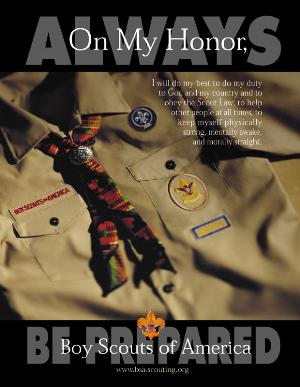
|
- The Boy Scouts of America (BSA) is the largest
youth organization in the United States, with over five
million members in its age-related divisions. Since its
founding in 1910 as part of the international
Scout Movement, more than 110 million Americans have
been members of the BSA.[2]
- The BSA seeks to train youth in responsible citizenship,
character development, and self-reliance through
participation in a wide range of outdoor activities,
educational programs, and, at older age levels,
career-oriented programs in partnership with community
organizations. For younger members, the
Scout method is used to inculcate typical Scouting
values such as honesty, good citizenship, and outdoors
skills, through a variety of activities such as camping,
aquatics, and hiking.[3][4]
- The BSA is a constituent member of the
World Organization of the Scout Movement. The
traditional Scouting divisions are Cub Scouting for
boys ages 7–10, Boy Scouting for boys ages 10–17 and
Venturing for young men and women ages 14–21.
Learning for Life is a
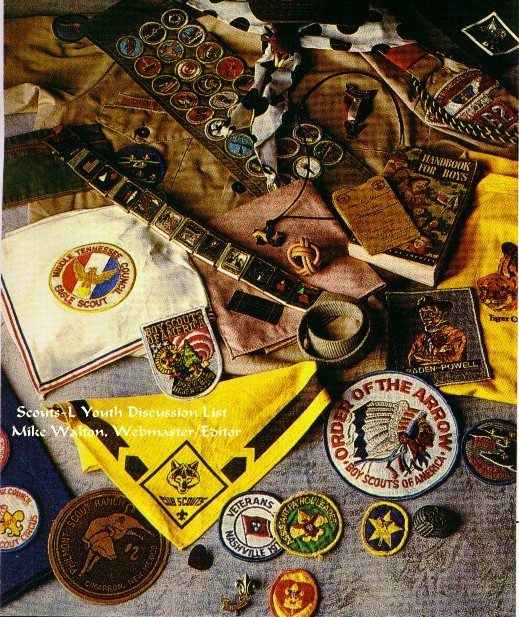 non-traditional subsidiary that
provides in-school and career education.[1][5]
The BSA operates traditional Scouting locally through units
sponsored and operated by churches, clubs, civic
associations, educational organizations and the like. Units
are led entirely by volunteers who are supported by local
councils using both paid professionals and volunteers. non-traditional subsidiary that
provides in-school and career education.[1][5]
The BSA operates traditional Scouting locally through units
sponsored and operated by churches, clubs, civic
associations, educational organizations and the like. Units
are led entirely by volunteers who are supported by local
councils using both paid professionals and volunteers.
- The influence of Scouting on American society is
frequently cited by both its advocates and critics. In
addition to nostalgic memories of campfires kindling
friendships, prominent leaders in various fields of endeavor
have credited the skills they learned in Scouting as helping
mold them into successful citizens. Critics have called the BSA's membership restrictions pertaining to avowed atheists
and homosexuals unfair, resulting in litigation in various
state and federal courts.
- The Scout method is the informal
educational system used by
Scouting. The aim of
Scouting is character training, to become an independent
person, helpful to other people.[1]
Thereby Scouts will become "healthy, happy, helpful
citizens"[2]
- The Scout method by which this aim is achieved
suggests attractive games in the primitive outdoors, giving
challenges which a Scout learns to solve by himself.[1]
Therefore, a Scout is given independence, leadership, the
ambition to learn by himself, a law with positive goals, and
the example of the leader. According to founder
Robert Baden-Powell, the Scout method works naturally
and unconsciously: naturally in the way that it follows the
natural impulses of a Scout, unconsciously in the way that
the Scout is not aware of the education.
- The Scout Law embodies the joint values of the Scouting
movement all over the world which binds all Scouts together.
The
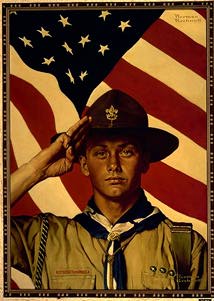 emphasis on "Learning by doing" provides experiences and
hands on orientation as a practical method of learning and
confidence building. Small groups build unity and a
brotherly atmosphere to develop responsibility, character,
self-reliance and self-confidence, reliability, and
readiness; which eventually leads to collaboration and
leadership. An attractive program of varying activities
expands a Scout's horizons and bonds the Scout even more to
the group. Activities and games develop handiness and
provide a fun way to develop skills. In an outdoor setting,
these also provide contact with nature and the environment. emphasis on "Learning by doing" provides experiences and
hands on orientation as a practical method of learning and
confidence building. Small groups build unity and a
brotherly atmosphere to develop responsibility, character,
self-reliance and self-confidence, reliability, and
readiness; which eventually leads to collaboration and
leadership. An attractive program of varying activities
expands a Scout's horizons and bonds the Scout even more to
the group. Activities and games develop handiness and
provide a fun way to develop skills. In an outdoor setting,
these also provide contact with nature and the environment.
Boy Scouts
Boy Scouting was the BSA's original program, begun in 1910.
- Age Range. The upper age limit for Boy Scout
troops has always been 18. For almost 40 years, the entry age was
12. The BSA lowered the entry age to 11 in 1949. In 1972, the entry
age was slightly lowered again, to 10-1/2 if a boy had finished
Fifth Grade. In 1988, the age limit was further adjusted to allow a
boy to join either at age 11, or upon completion of Fifth Grade
regardless of age, or upon earning the Webelos Arrow of Light award;
in 2004, this requirement was clarified to set the minimum age at
10.
- Ranks. The earliest Scouts could earn only three
ranks: Tenderfoot, Second Class, and First Class, which covered
basic Scouting skills. The BSA soon added three higher ranks to
recognize First Class Scouts who earned merit badges: Life (5 merit
badges), Star (10 merit badges), and Eagle (21 merit badges). In
1925, Star was placed before Life (because the five points of a star
could represent five merit badges). Over the years, the advancement
plan has changed little in its overall structure, but specific
requirements have been changed many times.
- Basic Skills and Skill Awards. The first three
ranks have always contained a long list of basic skills to learn. In
1972, this list was reorganized into 12 "skill awards." Each skill
award was a metal belt loop that provided "instant recognition" for
completing a group of related skills (the 12 awards were: Camping,
Citizenship, Communications, Community Living, Conservation,
Cooking, Environment, Family Living, First Aid, Hiking, Physical
Fitness, Swimming). In 1989, the BSA dropped the skill awards,
returning to the system used before 1972.
- Merit Badges. Prior to 1972, the BSA felt that
working on merit badges might distract
 younger Scouts from learning
the basic Scout skills taught in the first three ranks. So Scouts
had to be Second Class before they were allowed to earn merit
badges. In 1972, the merit badge program was opened up to any Scout
regardless of rank, and a certain number of merit badges was
required for all ranks (including First Aid and Citizenship in the
Community for First Class). In 1976, the merit badge for Tenderfoot
was dropped and the number required for Second Class and First Class
was reduced. In 1979, the remaining merit badge for Second Class was
dropped, and the number required for First Class was reduced to one
(First Aid). Finally, in 1989, the requirement to earn First Aid for
First Class was dropped (First Aid is still on the Eagle list). As a
result, the merit badge requirements for the ranks have come almost
full circle since 1972. younger Scouts from learning
the basic Scout skills taught in the first three ranks. So Scouts
had to be Second Class before they were allowed to earn merit
badges. In 1972, the merit badge program was opened up to any Scout
regardless of rank, and a certain number of merit badges was
required for all ranks (including First Aid and Citizenship in the
Community for First Class). In 1976, the merit badge for Tenderfoot
was dropped and the number required for Second Class and First Class
was reduced. In 1979, the remaining merit badge for Second Class was
dropped, and the number required for First Class was reduced to one
(First Aid). Finally, in 1989, the requirement to earn First Aid for
First Class was dropped (First Aid is still on the Eagle list). As a
result, the merit badge requirements for the ranks have come almost
full circle since 1972.
- Eagle Scout. The Eagle rank was established as
Scouting's highest award in 1911,
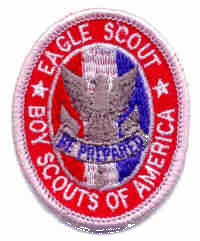 and the first Eagle badge was
awarded in 1912. Today, well over a million boys and men have earned
the Eagle badge (adults could earn Eagle until 1952). At first,
Eagle recognized simply earning 21 merit badges. Later, requirements
for leadership and service were added. [A comparison of the Eagle
Scout requirements from 1911 to the present can be found on Troop 97
Eagle
Requirements page.] and the first Eagle badge was
awarded in 1912. Today, well over a million boys and men have earned
the Eagle badge (adults could earn Eagle until 1952). At first,
Eagle recognized simply earning 21 merit badges. Later, requirements
for leadership and service were added. [A comparison of the Eagle
Scout requirements from 1911 to the present can be found on Troop 97
Eagle
Requirements page.]
- Board of Review/Court of Honor. Until the early
1950s, troops were generally not allowed the authority to pass off
merit badges and ranks. Rather, a Scout was reviewed for his merit
badges and ranks at a district or council Court of Honor. The Scout
usually received his badge the same evening. Later, as individual
troops gradually took over the reviewing and presentation process,
the review became separated from the Court of Honor presentation.
Since awards could only be presented at Courts of Honor (usually
four times a year), Scouts were forced to wait as long as three
months to receive the rank or merit badge they had earned. The BSA
remedied this problem in 1972 by directing troops to present badges
as soon as they were earned. The Court of Honor then became a
second, more formal recognition in front of parents.
- SPL/PLC. Early Scoutmasters ran their troops
much more directly than today's leaders,
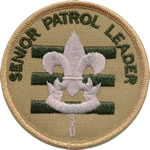 since they had no Senior
Patrol Leader (SPL) and no Patrol Leader Council (PLC). The office
of SPL was not created until 1919. The early SPL was usually also a
Patrol Leader, who chaired the Patrol Leader Council as a SENIOR
Patrol Leader. Gradually, the modern organization developed, with
the SPL and Patrol Leaders meeting to plan the troop's activities,
and the Scoutmaster acting as an advisor. since they had no Senior
Patrol Leader (SPL) and no Patrol Leader Council (PLC). The office
of SPL was not created until 1919. The early SPL was usually also a
Patrol Leader, who chaired the Patrol Leader Council as a SENIOR
Patrol Leader. Gradually, the modern organization developed, with
the SPL and Patrol Leaders meeting to plan the troop's activities,
and the Scoutmaster acting as an advisor.
- Older-boy Options. In an attempt to keep older
boys in Scouting, the BSA has often provided a special older-boy
program and older-boy patrol within the troop structure. Until the
1950s, this was typically a Sea Scout or Explorer "crew." From 1972
to 1989, it was the Leadership Corps. Since 1990, it has been
Venture Scouting (high adventure theme) and Varsity Scouting (sports
theme; Varsity has also existed as an optional program totally
separate from a Scout troop since 1984). Many troops have
additionally grouped older Scouts into some sort of "Senior" Patrol.
- Adult Leaders. All troop adult leader positions
have always been open to men. For over 50 years, women were excluded
from troop operation except for an optional "mothers auxiliary."
More recently, women were allowed to hold any troop committee
position but not Scoutmaster or Assistant Scoutmaster. Finally in
1988, the BSA opened these positions to women also. As a result, all
adult positions in the Boy Scouting Division (as well as in the
other Divisions) are now open to both men and women.
|
|
 |
 |
|
 |
 |
 |
 |
|
|
|
|
|
|
|
|
|